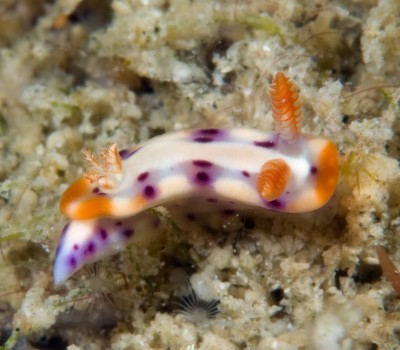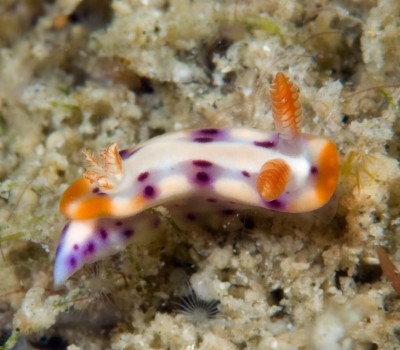
Thorunna sp. 3
Order: NUDIBRANCHIA
Family: Chromodorididae
PHOTO
Locality: Tablamu, 6 metres, Phangnga, Thailand, Andaman Sea, 27 February 2010, Rocky shoreline. Length: Approx. 8 mm. Photographer: Lawrence Neal.
From the orange mark on the front of the mantle this is most probably a species of Thorunna, but if so, it does not seem to fit any existing species - even allowing for a bit of variation. It could well be a juvenile, but even so it doesn't seem to fit.
Rudman, W.B., 2010 (March 29) Thorunna sp. 3 [In] Sea Slug Forum. Australian Museum, Sydney. Available from http://www.seaslugforum.net/find/thorsp3
Related messages
Re: Thorunna sp.? from the Andaman Sea
April 7, 2010
From: Erwin Koehler
Concerning message #23331:
dear Bill,
Mike has a nice video by John Greenamyer of it at
http://www.slugstream.org/flash/noumeasp.flv
as Noumea sp.
Erwin
Erwin@medslugs.de
Koehler, E., 2010 (Apr 7) Re: Thorunna sp.? from the Andaman Sea. [Message in] Sea Slug Forum. Australian Museum, Sydney. Available from http://www.seaslugforum.net/find/23441Dear Erwin,
Thanks for the link. I am afraid identifying small species of chromodorid to genus is very difficult without any information on their anatomy. If we are lucky and can see them, the position of the mantle glands can give us a clue. For example, in many species of Thorunna the mantle glands appear to be absent or invisible but in a few cases they follow the hypselodorid arrangement with a concentration of glands at the mantle edge behind the gills and a few at the anterior end of the body. Although I can't see the posterior glands in Lawrence Neal's photo, the posterior end of the mantle is constricted into shape suggestive of a gland mass. Similarly, I can see a couple of large white glands at the anterior end. Although not conclusive, my guess is that the mantle glands in this animal are hypselodorid in arrangement. In species of Noumea, the glands usually follow a chromodorid arrangement with a submarginal band of uniformly sized glands right around the mantle.
The other point I noticed was the orange 'crescent'-shaped mark at the anterior end of the mantle. At present the only animals I have seen with such a mark have been species of Thorunna.
I realise these are not very substantial features but if I have to choose between Thorunna and Noumea the little information I have all suggests Thorunna. But it is always possible it belongs to neither of these genera.
Best wishes,
Bill Rudman
Thorunna sp.? from the Andaman Sea
March 29, 2010
From: Lawrence Neal

Concerning message #23323:
Dear Bill,
I wonder if you have any thoughts on this little nudibranch from the Andaman Sea? Perhaps a species of Thorunna? The shape and size are in the right ball park.
It was crawling on sponge- and sediment-covered rocks quite close to the shore. Several other small species of Thorunna, Noumea and Hypselodoris are at home in this area too.
Locality: Tablamu, 6 metres, Phangnga, Thailand, Andaman Sea, 27 February 2010, Rocky shoreline. Length: Approx. 8 mm. Photographer: Lawrence Neal.
All the best,
Lawrence
lorenzo_n@yahoo.com
Neal, L., 2010 (Mar 29) Thorunna sp.? from the Andaman Sea. [Message in] Sea Slug Forum. Australian Museum, Sydney. Available from http://www.seaslugforum.net/find/23331Dear Lawrence,
From the orange mark on the front of the mantle this is most probably a species of Thorunna, but if so, it does not seem to fit any existing species - even allowing for a bit of variation. It could well be a juvenile, but even so it doesn't seem to fit.
I think I will call it Thorunna sp. 3 until we know more.
Best wishes,
Bill Rudman
